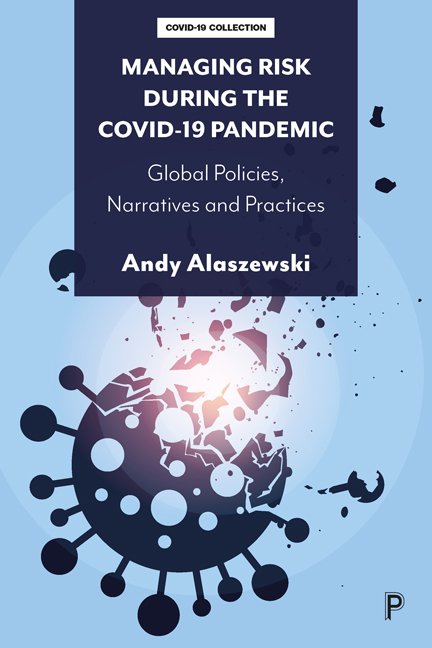Book contents
- Frontmatter
- Dedication
- Contents
- List of tables
- List of abbreviations
- About the author
- Acknowledgements
- Foreword
- Preface
- 1 Introduction: risk as a key feature of late modern societies
- PART I Responding to the challenges of the pandemic
- PART II Mitigating risk through science and technology
- PART III Risk narratives
- References
- Index
10 - Conclusion: risk and the pandemic
Published online by Cambridge University Press: 20 January 2024
- Frontmatter
- Dedication
- Contents
- List of tables
- List of abbreviations
- About the author
- Acknowledgements
- Foreword
- Preface
- 1 Introduction: risk as a key feature of late modern societies
- PART I Responding to the challenges of the pandemic
- PART II Mitigating risk through science and technology
- PART III Risk narratives
- References
- Index
Summary
Risk: technical rationality and beyond
The COVID-19 pandemic was inextricably linked to risk. As I note in Chapter 1, risk can be used as a technical concept, a means of using evidence from the past to predict and control the future. It provides a way of predicting the incidence of natural events such as epidemics caused by pathogenic microbes. Risk is also shaped by social relationships. One of its key elements, outcomes, acquires meaning because of its social significance, with distinct values attached to different outcomes. Given such values, social actions are shaped by the desire to minimise bad outcomes. In contemporary societies, it is accepted that governments should seek to protect the public by identifying and mitigating risks. The pandemic provides an opportunity to consider the ways in which governments seek to do this, and the relative success and failure of their choices,
The challenge of dealing with a novel disease
In early 2020, SARS-CoV-2 was a novel virus, and therefore it was difficult to use traditional public health techniques based on epidemiology to predict its impact and to plan responses; there was no evidence on which to base risk assessments. At the start of the pandemic, policy makers had to find a way of making sense of the threat posed by COVID-19. They framed the new disease in different ways, and these frames had important impact on the way in which COVID-19 spread from a localised outbreak in Wuhan into a global pandemic, which within two years had infected over 435 million people and killed nearly 6 million (Johns Hopkins University, 2022).
Framing COVID-19 as a highly infectious lethal disease such as SARS or Ebola
Countries with previous experience of outbreaks of rapidly spreading and highly lethal diseases such as SARS or Ebola mostly framed the new virus in those terms, as a highly infectious and lethal virus, but one that could be identified and controlled using strict public health measures such as travel restrictions, quarantine and track and isolate.
Countries that framed COVID-19 as SARS initially managed the disease effectively, mostly limiting its spread to sporadic cases or small clusters.
- Type
- Chapter
- Information
- Managing Risk during the COVID-19 PandemicGlobal Policies, Narratives and Practices, pp. 151 - 161Publisher: Bristol University PressPrint publication year: 2023



